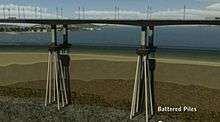Batter (walls)
.jpg)
Batter in architecture is a receding slope of a wall,[2] structure, or earthwork. A wall sloping in the opposite direction is said to overhang.[3]
The term is used with buildings and non-building structures to identify when a wall is intentionally built with an inward slope. A battered corner is an architectural feature using batters. A batter is sometimes used in foundations, retaining walls, dry stone walls, dams, lighthouses, and fortifications. Other terms that may be used to describe battered walls are "tapered" and "flared".
Walls may be battered to provide structural strength or for decorative reasons. In military architecture they made walls harder to undermine or tunnel, and provided some defence against artillery, especially early siege engine projectiles and cannon, where the energy of the projectile might be largely deflected, on the same principle as modern sloped armour. Siege towers could not be pushed to next to the top of a strongly battered wall. Types of fortification using batters included the talus and glacis.
Achitectural styles that often include battered walls as a stylistic feature include Indo-Islamic architecture, where it was used in many tombs and some mosques, as well as many forts in India. Tughlaqabad Fort in Delhi is a good example, built by Ghiyath al-Din Tughluq, whose tomb opposite the fort (illustrated above) also has a strong batter. In Hindu temple architecture, the walls of the large gopurams of South India are usually battered, often with a slight concave curve.
The batter angle is typically described as a ratio of the offset and height or a degree angle.
Gallery
.jpg) The Krak des Chevaliers, with a tall and clearly defined talus
The Krak des Chevaliers, with a tall and clearly defined talus- A batter frame is used to guide the construction of a battered stone wall.
 Batter describes the intentional inclination of these pilings.
Batter describes the intentional inclination of these pilings. Battered buttresses reinforce this wall.
Battered buttresses reinforce this wall. Ancient Egyptian pylons were often battered.
Ancient Egyptian pylons were often battered.
References
- ↑ Blair, Sheila, and Bloom, Jonathan M., The Art and Architecture of Islam, 1250-1800, p. 154, 1995, Yale University Press Pelican History of Art, ISBN 0300064659
- ↑ "Batter v.2. def. 1 and 2. and "Batter n.2". Oxford English Dictionary Second Edition on CD-ROM (v. 4.0) © Oxford University Press 2009
- ↑ Whitney, William Dwight. "Batter 2." The Century Dictionary. New York: Century, 1889. 476-77. Print.